Rosendal, South Africa – In the small farming town of Rosendal, life moves at a different pace. With only about 100 residents, it feels slow here, at least compared to the bustle of Johannesburg, about 205 miles (330 kilometers) to the north. Long stretches of red dirt roads cross the town, and at night, pockets of darkness separate one street light from another.
For the members of the arts community that call Rosendal home, the breathtaking views of mountains, the rusted windmills and hand-painted signs pointing toward the restaurant that serves up waffels – vah-fills in Afrikaans – are exactly the appeal of the place.
Michele Nigrini, one of the artists who live in Rosendal, owns a studio and art gallery along one of the main roads in town. The outside of Nigrini’s one-story shop is grey, accented with a hand-painted white floral pattern. Just above the front door hangs a wooden hand-lettered sign that welcomes visitors to the Michele Nigrini Studio.
Inside her studio, Nigrini has created four specific design areas. In one room Nigrini positions her easel to face the windows, where she gains much of her artistic inspiration. In that same room are two tables covered with paint stains and filled with brushes, palettes and canvases. In the other room she focuses on animation design work.

“I have an attention problem,” Nigrini said. “When I get bored in the one room, then I move to another table or into another room. I can’t sit long and concentrate on one thing.”
Part of Rosendal’s draw is that it allows artists like Nigrini spatial capital for their creativity to roam free.
“I have the space here to do that kind of thing,” said Nigrini. “When I was in Paris, it was a small little room, one table, and that was also fine. You adapt to what you have around you. But I enjoy the studio here, and the freedom, and seeing the cows walking by as opposed to cars.”
Nigrini was born, raised and spent most of her adult life and career in Pretoria where she first discovered her love for art. In 2004, she first visited Rosendal for three days to plan a 12-month sabbatical there, never imagining it would become her new home.

Nigrini said she ultimately chose to leave the only home she had ever known “because there were no jones to keep up with” in Rosendal.
But there was her friend Frik de Jager, a retired farmer and writer, who settled in Rosendal in order to open up a small store to enjoy his retirement.
When de Jager arrived in Rosendal, there were already a few other artists and writers there. He knew Nigrini would thrive there, too.
“I convinced Michele to come,” de Jager said. “And between the two of us, we selected friends and invited them, mostly artists, to come and live here. That’s how it started.”
Now a resident of Rosendal for nearly 15 years, Nigrini continues to draw her inspiration from the community–and from the landscape, which she said has changed her artwork.
“When I came here, it was more about the nature and the feel,” said Nigrini. “Even if I didn’t paint the nature, it felt as if the tranquility of it influenced my work. Artists mostly produce the emotion that they feel.”
Both Nigrini and de Jager said the community of Rosendal is changing. When de Jager first came to Rosendal, he was among a group of middle-aged newcomers.
“I’m one of the oldies now,” said de Jager. “Sixteen years ago I was one of the younger ones. Now there is a whole new influx of 30-somethings, professionals who are making it work from here.”
Nigrini said she thinks young people are choosing to move to Rosendal to escape the busy life that social media and the city has imposed on them in a technological age.
“Young people want to be here,” said Nigrini. “They want this kind of life. I think it’s less busy. It’s back to the old days.”















































